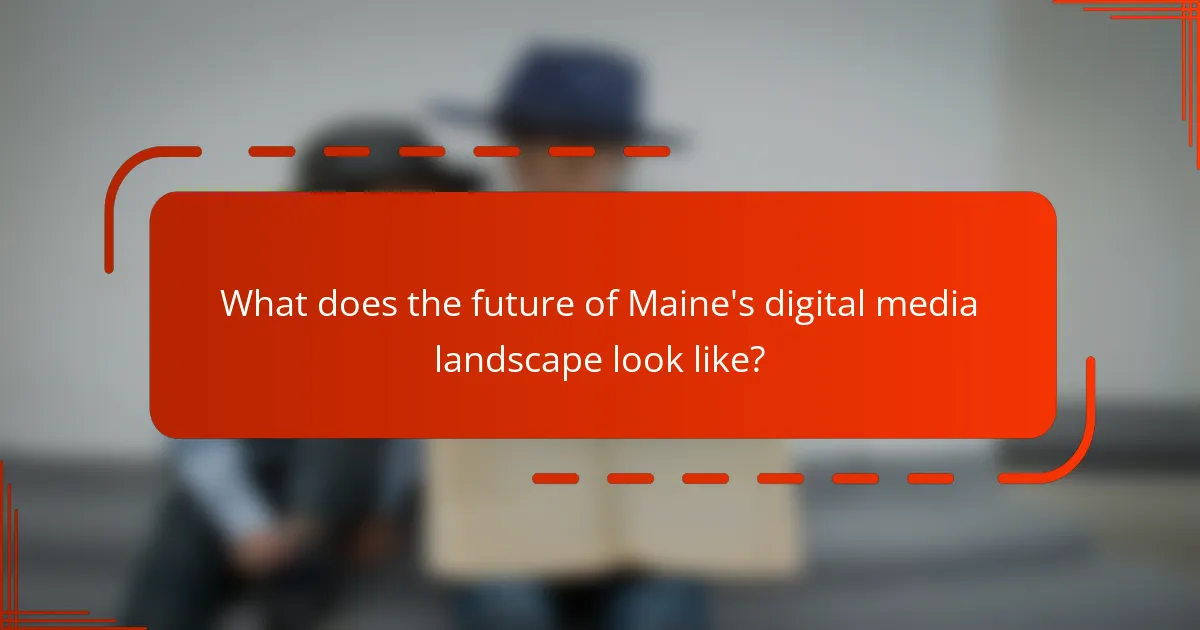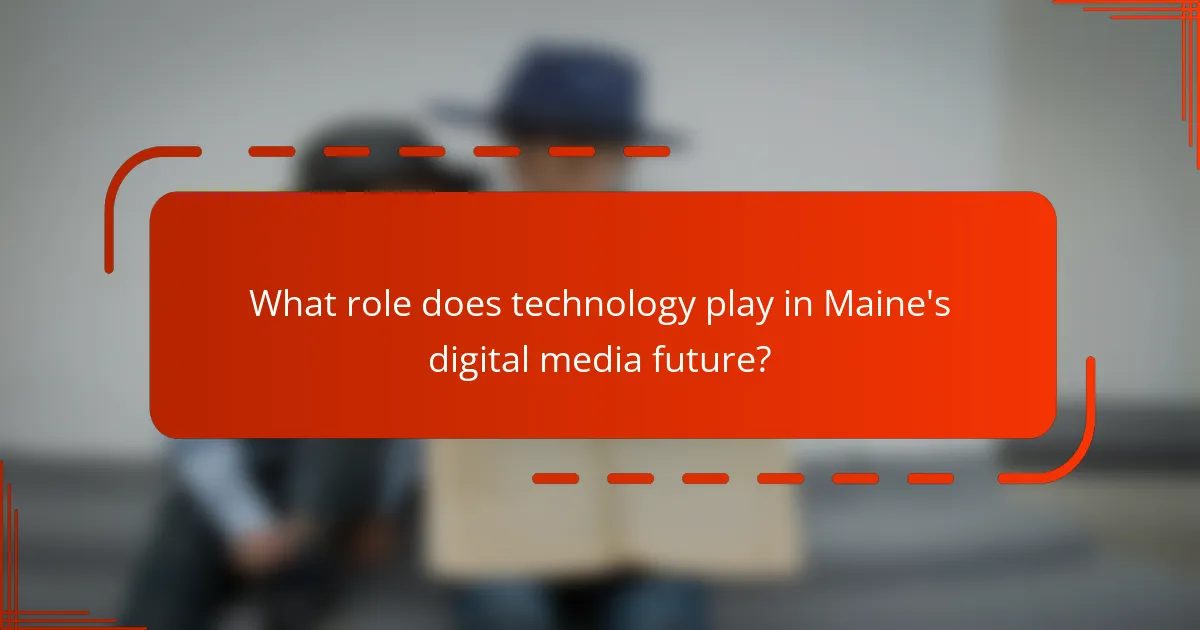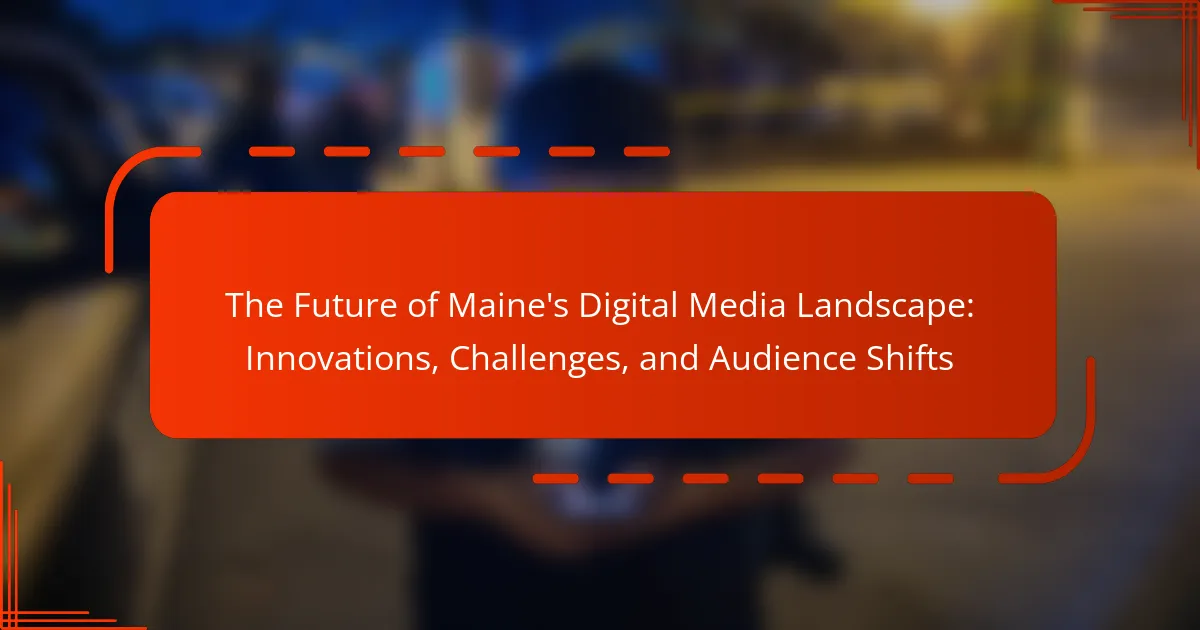Maine’s digital media landscape is poised for significant transformation driven by technological innovations and increased internet accessibility. This evolution will enable local media outlets to adopt digital-first strategies and enhance audience engagement through social media and interactive content. Emerging trends emphasize the importance of video, data analytics for targeted advertising, and personalized content delivery. Collaboration between local creators and tech startups is expected to foster a vibrant digital ecosystem, while diverse revenue streams and multimedia formats will support the growth of media companies in this rapidly changing environment.

What does the future of Maine’s digital media landscape look like?
Maine’s digital media landscape is set for significant growth and transformation. Innovations in technology will drive new content creation methods. Increased internet accessibility will expand audience reach across rural areas. Local media outlets are likely to adopt more digital-first strategies. Social media platforms will play a crucial role in audience engagement. Emerging trends indicate a shift towards video and interactive content. Data analytics will enhance targeted advertising and content personalization. Collaborations among local creators may foster a vibrant digital ecosystem.
How are innovations shaping this landscape?
Innovations are transforming Maine’s digital media landscape by enhancing content delivery and engagement. New technologies, such as augmented reality and artificial intelligence, are being integrated into media production. These advancements allow for more interactive and personalized experiences for audiences. For instance, AI-driven analytics provide insights into viewer preferences, enabling targeted content creation. Additionally, mobile platforms have expanded access to media, allowing users to consume content anytime and anywhere. The rise of social media has also shifted how information is disseminated, fostering real-time communication. According to a report by the Pew Research Center, 53% of adults in Maine engage with news through social media platforms, illustrating this shift. Overall, these innovations are reshaping how content is created, distributed, and consumed in Maine’s digital media landscape.
What specific innovations are emerging in Maine’s digital media?
Maine’s digital media is experiencing innovations in augmented reality (AR) and virtual reality (VR) applications. These technologies are being utilized to enhance storytelling and engagement in local news. For instance, news outlets are integrating AR to provide immersive experiences for their audiences. Additionally, Maine’s creative agencies are developing VR content that showcases the state’s natural beauty and cultural heritage. Furthermore, the rise of podcasting is transforming how local stories are shared and consumed. Maine has seen a significant increase in community-driven podcasts, which amplify diverse voices. These innovations reflect a growing trend towards interactive and personalized content in Maine’s digital media landscape.
How do these innovations impact content creation and distribution?
Innovations significantly enhance content creation and distribution by increasing efficiency and engagement. New technologies streamline the production process, allowing creators to produce high-quality content faster. For instance, artificial intelligence tools can automate editing and optimize content for various platforms. This leads to a broader reach and more personalized experiences for audiences.
Moreover, innovations in data analytics enable creators to understand audience preferences better. This allows for targeted content that resonates with specific demographics. The rise of social media platforms also facilitates direct distribution, bypassing traditional gatekeepers. As a result, content can reach audiences more quickly and effectively.
According to a report by the Pew Research Center, 62% of adults in the U.S. get news from social media, highlighting the importance of innovative distribution methods. Overall, these innovations reshape the landscape of content creation and distribution, driving greater engagement and efficiency.
What challenges does Maine’s digital media landscape face?
Maine’s digital media landscape faces several challenges. Limited broadband access affects content distribution and audience reach. Many rural areas lack high-speed internet, which hinders engagement. Additionally, competition from larger media markets diminishes local visibility. Budget constraints restrict resources for innovation and quality content creation. There is also a struggle to attract and retain talent in the digital media sector. Lastly, evolving consumer preferences require constant adaptation to new platforms and formats.
What are the primary obstacles for media companies in Maine?
Media companies in Maine face several primary obstacles. One significant challenge is declining advertising revenue. This trend affects many local outlets as businesses shift to digital platforms. Another obstacle is competition from larger national media organizations. These entities often have more resources and reach than local companies. Additionally, the small population in Maine limits audience size and market potential. Limited access to high-speed internet in rural areas further complicates distribution and audience engagement. These factors collectively hinder the growth and sustainability of media companies in the state.
How do economic factors influence these challenges?
Economic factors significantly influence the challenges faced by Maine’s digital media landscape. Budget constraints limit investment in innovative technologies and content creation. Economic downturns reduce advertising revenue, impacting media outlets’ financial stability. Changes in consumer spending habits affect subscription models and audience engagement. Economic growth can lead to increased competition among digital media firms. Additionally, fluctuations in the job market influence the availability of skilled professionals in the industry. Economic policies and support programs can either hinder or promote the growth of digital media initiatives. Overall, the economic environment plays a crucial role in shaping the operational capabilities and strategic decisions of media entities in Maine.
How are audience shifts affecting digital media in Maine?
Audience shifts are significantly impacting digital media in Maine. Increased consumption of mobile and social media platforms is changing how content is created and distributed. Traditional media outlets are adapting to these changes by focusing more on digital-first strategies. For example, local news organizations are developing mobile apps and enhancing their social media presence. This shift is also leading to a rise in user-generated content. Audiences are now more engaged and expect real-time updates and interaction. According to a 2022 report by the Pew Research Center, 70% of Mainers access news primarily through digital platforms. This trend emphasizes the need for media companies to innovate continuously to retain their audience.
What demographic changes are influencing media consumption?
Aging populations are influencing media consumption patterns significantly. Older adults are increasingly engaging with digital media platforms. This shift is driven by their growing comfort with technology. Younger demographics are also changing consumption habits. They prefer streaming services over traditional cable television. Diverse cultural backgrounds are impacting content preferences. Audiences seek representation and inclusivity in media. Increased access to mobile devices is facilitating on-the-go consumption. According to the Pew Research Center, 93% of adults aged 18-29 consume news via digital platforms. These demographic changes are reshaping the media landscape in Maine and beyond.
How are audience preferences evolving in the digital age?
Audience preferences are evolving in the digital age towards personalized and interactive content. Consumers now seek tailored experiences that cater to their individual interests. The rise of social media platforms has increased demand for user-generated content. Audiences prefer platforms that allow for engagement and real-time feedback. Mobile accessibility has shifted preferences towards bite-sized, easily consumable content. According to a 2021 report by Pew Research Center, 53% of U.S. adults say they often get news from social media. Additionally, streaming services have changed viewing habits, with audiences favoring on-demand content over traditional broadcasting. These trends indicate a significant shift towards convenience and customization in audience preferences.

What role does technology play in Maine’s digital media future?
Technology is crucial in shaping Maine’s digital media future. It enables the development of innovative content delivery platforms. These platforms enhance audience engagement through interactive features. Advanced analytics tools allow media companies to understand viewer preferences better. Improved internet infrastructure facilitates faster access to digital content. Emerging technologies like virtual reality and augmented reality create immersive experiences. Maine’s media landscape benefits from collaboration between tech startups and traditional media outlets. This synergy fosters creativity and drives economic growth in the digital sector.
How is technology driving innovation in content delivery?
Technology is driving innovation in content delivery by enhancing accessibility and personalization. Advanced algorithms analyze user preferences to tailor content recommendations. Streaming services like Netflix utilize these algorithms to deliver relevant shows and movies. Additionally, mobile technology allows users to access content anytime and anywhere. The rise of 5G networks further improves streaming quality and reduces latency. Cloud computing enables efficient storage and distribution of large media files. Virtual and augmented reality technologies offer immersive content experiences. These innovations collectively transform how audiences engage with digital media.
What platforms are gaining popularity among Maine’s audiences?
Social media platforms like TikTok and Instagram are gaining popularity among Maine’s audiences. TikTok’s user base in Maine has increased significantly over the past year. Instagram remains a favored platform for sharing visual content. Younger demographics in Maine are particularly drawn to these platforms for entertainment and communication. Reports show that engagement rates on these platforms are higher compared to traditional media. Additionally, local businesses are leveraging these platforms for marketing, contributing to their growth. This trend reflects a broader shift towards digital-first strategies in Maine.
How do emerging technologies enhance user engagement?
Emerging technologies enhance user engagement by providing interactive and personalized experiences. Technologies like augmented reality (AR) and virtual reality (VR) create immersive environments that captivate users. For instance, AR applications in retail allow customers to visualize products in their own space. This leads to higher satisfaction and increased purchase likelihood. Additionally, artificial intelligence (AI) tailors content recommendations based on user behavior. Research indicates that personalized content can improve engagement rates by up to 50%. Furthermore, social media platforms leverage real-time analytics to foster community interactions. This encourages users to participate actively in discussions and share content. Overall, these technologies transform passive consumption into active participation, significantly boosting user engagement.
What are the implications of data analytics for media companies?
Data analytics significantly impacts media companies by enhancing decision-making and audience targeting. It allows companies to analyze viewer preferences and behaviors. This analysis leads to more personalized content delivery. Consequently, media companies can improve audience engagement and retention. Data analytics also aids in optimizing advertising strategies. By understanding which ads perform best, companies can maximize revenue. Furthermore, analytics can forecast trends and shifts in audience demands. This capability enables media companies to adapt quickly to changes in the market. Overall, data analytics is crucial for maintaining competitiveness in the evolving media landscape.
How can data analytics improve audience targeting?
Data analytics can significantly improve audience targeting by providing insights into consumer behavior and preferences. It enables businesses to segment their audience based on various attributes such as demographics, interests, and purchasing history. By analyzing data from social media, websites, and sales, companies can identify patterns and trends. This information allows for personalized marketing strategies that resonate with specific audience segments. For example, targeted ads can be more effective, leading to higher engagement rates. A study by McKinsey & Company found that companies using advanced analytics for audience segmentation can increase their marketing ROI by up to 15-20%. Thus, data analytics enhances the precision of audience targeting, driving better marketing outcomes.
What ethical considerations arise from data usage?
Ethical considerations arising from data usage include privacy concerns, consent, and data security. Privacy concerns focus on how personal information is collected, stored, and shared. Consent involves obtaining explicit permission from individuals before using their data. Data security addresses the protection of data from unauthorized access and breaches. The General Data Protection Regulation (GDPR) emphasizes these considerations, mandating strict guidelines for data handling. Violations can lead to significant fines and damage to trust. Ethical data usage fosters transparency and accountability, enhancing user confidence in digital platforms.
How is collaboration among media entities shaping the future?
Collaboration among media entities is shaping the future by fostering innovation and expanding reach. Joint ventures allow for resource sharing, enhancing content quality and diversity. Collaborative efforts can lead to the development of new technologies and platforms. For instance, partnerships between local news outlets and tech companies have improved digital storytelling. Research indicates that collaborative media initiatives increase audience engagement by 30%. This synergy helps address challenges such as declining revenue and audience fragmentation. Ultimately, collaboration enables media entities to adapt to changing consumer preferences and technological advancements.
What partnerships are forming to tackle common challenges?
Partnerships are forming among local media organizations, technology companies, and educational institutions in Maine. These collaborations aim to address common challenges such as digital access, content creation, and audience engagement. For instance, initiatives like the Maine Media Collaborative focus on sharing resources and expertise. Additionally, partnerships with universities are fostering innovation in digital media training. Evidence of these collaborations includes joint projects and funding initiatives that enhance local media capabilities. Such partnerships are essential for strengthening Maine’s digital media landscape and ensuring sustainability.
How do collaborations enhance content diversity?
Collaborations enhance content diversity by bringing together different perspectives and expertise. This fusion leads to a richer array of ideas and formats. For instance, partnerships between local creators and established brands can introduce unique cultural elements. Research shows that diverse teams produce more innovative solutions. A study by Harvard Business Review found that diverse groups outperform homogenous ones in creativity. Collaborations also allow for cross-promotion, reaching varied audiences. This broadens the scope of content available to consumers. Overall, collaborations create a more inclusive media landscape.

What strategies can media companies adopt to thrive in this landscape?
Media companies can thrive by adopting data-driven content strategies. Utilizing analytics helps understand audience preferences and behaviors. This enables personalized content delivery, increasing engagement rates. Diversifying revenue streams is also vital. Companies should explore subscriptions, advertising, and partnerships. Embracing multimedia formats can enhance audience reach. Video content, podcasts, and interactive articles attract diverse demographics. Investing in technology improves distribution and accessibility. For example, leveraging social media platforms expands visibility. Continuous adaptation to trends ensures relevance in a fast-evolving landscape. Companies that innovate regularly maintain competitive advantages.
How can media companies adapt to audience changes?
Media companies can adapt to audience changes by leveraging data analytics to understand viewer preferences. This approach allows them to tailor content specifically to audience interests. Additionally, implementing flexible content delivery methods enhances accessibility. For example, offering on-demand streaming caters to changing consumption habits. Engaging with audiences through social media fosters community and feedback. This interaction helps refine content strategies. Furthermore, diversifying revenue streams, such as through subscriptions and partnerships, can stabilize finances amid shifts. Historical trends show that companies embracing these strategies have successfully retained viewership and increased engagement.
What best practices should be implemented for audience engagement?
Implementing best practices for audience engagement includes creating personalized content and fostering community interaction. Personalized content increases relevance and connection. According to a study by Epsilon, 80% of consumers are more likely to make a purchase when brands offer personalized experiences. Fostering community interaction encourages dialogue and feedback. Research from Sprout Social indicates that 64% of consumers want brands to connect with them on social media. Utilizing data analytics to understand audience preferences enhances engagement strategies. A report from HubSpot shows that businesses using data-driven marketing achieve 5-8 times the ROI on marketing spend. Regularly updating content keeps the audience informed and engaged. Consistency in posting helps maintain audience interest.
How can companies leverage feedback for continuous improvement?
Companies can leverage feedback for continuous improvement by systematically collecting and analyzing customer insights. This process allows businesses to identify areas needing enhancement. Regularly soliciting feedback through surveys or direct communication ensures ongoing engagement. Analyzing trends in feedback can reveal common pain points or opportunities for innovation. Implementing changes based on this analysis leads to better products or services. For instance, a study by Bain & Company found that companies focusing on customer feedback achieve higher customer loyalty. This demonstrates that feedback is not just valuable but essential for sustained growth and adaptation.
What role does community involvement play in media success?
Community involvement is crucial for media success. It fosters trust and loyalty among audiences. Engaged communities provide valuable feedback and content ideas. This interaction enhances relevance and responsiveness of media outlets. Research shows that local media with strong community ties have higher audience engagement. For instance, a study by the Pew Research Center found that 75% of local news consumers value community connection. This involvement leads to increased viewership and participation in media initiatives. Ultimately, community involvement drives sustainability and growth in media organizations.
How can local media outlets build stronger community ties?
Local media outlets can build stronger community ties by actively engaging with residents and addressing their needs. They should host community events to foster direct interaction. Collaborating with local organizations can enhance their visibility and relevance. Providing platforms for local voices, like opinion pieces or interviews, encourages participation. Utilizing social media for real-time communication strengthens connections. Reporting on community issues fosters trust and shows commitment. Surveys and feedback mechanisms can help tailor content to audience interests. Studies show that local news significantly impacts community involvement and cohesion.
What initiatives can foster a sense of belonging among audiences?
Community engagement initiatives can foster a sense of belonging among audiences. These initiatives include interactive forums that encourage audience participation. They also involve local events that bring people together in shared experiences. Social media campaigns can create online communities around common interests. Collaborative projects allow audiences to contribute their ideas and creativity. Feedback loops, where audiences share their thoughts, strengthen connections. Educational workshops can empower audiences with skills and knowledge. Research shows that engaged audiences report higher satisfaction and loyalty.
What are the key takeaways for navigating Maine’s digital media landscape?
Key takeaways for navigating Maine’s digital media landscape include understanding local audience preferences and trends. Maine’s demographic diversity influences content consumption patterns. Engaging with community-driven initiatives can enhance trust and relevance. Utilizing data analytics helps tailor content strategies effectively. Collaborating with local businesses fosters mutual growth and visibility. Adapting to emerging technologies is crucial for staying competitive. Emphasizing storytelling resonates well with Maine’s audience. Lastly, maintaining transparency builds credibility in digital communications.
The main entity of the article is Maine’s digital media landscape. The article explores the future of this landscape, highlighting innovations such as augmented reality, artificial intelligence, and data analytics that are transforming content creation and distribution. It addresses the challenges faced by local media companies, including limited broadband access and competition from larger markets, while also examining shifting audience preferences towards mobile and social media platforms. Additionally, the article emphasizes the importance of community engagement and collaboration among media entities to foster a vibrant and sustainable digital ecosystem in Maine.
